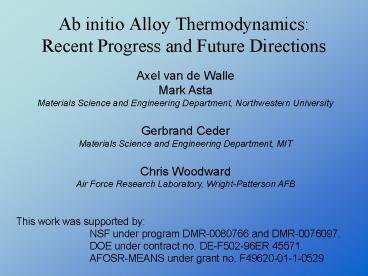Ab initio Alloy Thermodynamics: Recent Progress and Future Directions - PowerPoint PPT Presentation
1 / 29
Title:
Ab initio Alloy Thermodynamics: Recent Progress and Future Directions
Description:
Materials Science and Engineering Department, Northwestern University. Gerbrand Ceder. Materials Science and Engineering Department, MIT. Chris Woodward ... – PowerPoint PPT presentation
Number of Views:298
Avg rating:3.0/5.0
Title: Ab initio Alloy Thermodynamics: Recent Progress and Future Directions
1
Ab initio Alloy ThermodynamicsRecent Progress
and Future Directions
Axel van de Walle Mark Asta Materials Science and
Engineering Department, Northwestern
University Gerbrand Ceder Materials Science and
Engineering Department, MIT Chris Woodward Air
Force Research Laboratory, Wright-Patterson AFB
This work was supported by NSF under program
DMR-0080766 and DMR-0076097. DOE under contract
no. DE-F502-96ER 45571. AFOSR-MEANS under grant
no. F49620-01-1-0529
2
Goals
- Describe the current capabilities of ab initio
thermodynamic calculations - Illustrate how the Alloy Theoretic Automated
Toolkit (ATAT) can help perform such calculations
ATAT homepage http//cms.northwestern.edu/atat/
3
What can first-principles thermodynamic
calculations do for you?
Composition-temperature phase diagrams
Thermodynamics of stable and metastable phases,
Short-range order in solid solutions
Thermodynamic properties of planar defects
Precipitate morphology and Microstructures
Ducastelle (1991), Fontaine (1994), Zunger
(1994,1997), Ozolins et al. (1998), Wolverton et
al. (2000), Ceder et al. (2000), Asta et al.
(2000,2001)
4
Ab initio thermodynamic calculations
First-principles thermodynamic data
- Large number of atoms
- Many configurations
ATAT
Lattice model Monte Carlo Simulations
Vibrational entropy
Enthalpy
Electronic entropy
- Small number of atoms
- Few configurations
Quantum Mechanical Calculations
5
Outline
- Methodology
- Modeling configurational disorder
- Modeling lattice vibrations
- Applications (Ti-Al and Al-Mo-Ni)
- Sample input files
- Sample outputs
- Recent innovations
6
The Cluster Expansion Formalism
7
Coupled SublatticesMulticomponent Cluster
Expansion
Same basic form
Occupation variables
Decorated clusters
1
1
Not in cluster
1
2
Example binary fcc sublattice with ternary
octahedral sites sublattice
Sanchez, Ducastelle and Gratias (1984) Tepesch,
Garbulski and Ceder (1995)
8
Cluster expansion fit
Which structures and which clusters to include in
the fit?
9
Cross-validation
Example of polynomial fit
10
First-principles lattice dynamics
Computationally intensive!
First-principles data
Least-squares fit to Spring model
Phonon density of states
Direct force constant method (Wei and Chou
(1992), Garbuski and Ceder (1994), among many
others)
Thermodynamic Properties
11
Effect of lattice vibrations onphase stability
Stable without vibrations (incorrect)
Stable with vibrations (correct)
Ozolins and Asta (2001)
(Wolverton and Ozolins (2001))
How to handle alloy phase diagrams?
12
Coarse-Graining of the Free Energy
Graphical representation
Formally (Ceder (1993), Garbulski and Ceder
(1994-1996))
13
Coupling vibrational and configurational disorder
Need to calculate vibrational free energy for
many configurations
14
Efficient modeling of lattice vibrations
- Infer the vibrational entropies from bulk moduli
- (Moruzzi, Janak, and Schwarz, (1988))
- (Turchi et al. (1991), Sanchez et al. (1991),
Asta et al. (1993), Colinet et al. (1994)) - Calculate full lattice dynamics using tractable
energy models - (Ackland (1994), Althoff et al., (1997), Ravello
et al (1998), Marquez et al. (2003)) - Calculate lattice dynamics from first principles
in a small set of structures (Tepesch et al.
(1996), Ozolins et al. (1998)) - Transferable force constants (Sluiter et al.
(1999))
15
Bond length vs. Bond stiffness
Chemical bond type and bond length Good
predictor of nearest-neighbor force constants
(stretching and bending terms)
Relationship holds across different structures
van de Walle and Ceder (2000,2002)
16
Further tests...
Wu, Ceder, van de Walle (2002)
Au-Au bonds
Cu-Cu bonds
Au-Pd bonds
Pd-Pd bonds
Cu-Pd bonds
Au-Cu bonds
Accuracy 0.03 kB
17
Length-Dependent Transferable Force Constants
(LDTFC)
van de Walle and Ceder (2000,2002)
18
A matter of time
Time needed to complete a given first-principles
calculation
Human
Time
Computer
2003
1980
The procedure needs to be automated
19
The Alloy Theoretic Automated Toolkit
Lattice geometry
Ab initio code parameters
MAPS (MIT Ab initio Phase Stability Code) Cluster
expansion construction
Ab initio code (e.g. VASP, Abinit)
Effective cluster interactions
Ground states
Emc2 (Easy Monte Carlo Code)
Thermodynamic properties
Phase diagrams
20
Application to Ti-Al Alloys
Simple lattice input file
Simple ab initio code input file
21
Effective Cluster Interactions
22
Ground States Search
23
Ground state search inAl-Mo-Ni system
Mo (bcc)
Al (fcc)
Ni (fcc)
E
Mo
Ni3Al (L12)
NiAl (B2)
Ni
Al
24
Monte Carlo outputFree energies
Can be used as input to CALPHAD approach
25
Short-range order calculations
Energy cost of creating a diffuse anti-phase
boundary in a Ti-Al short-range ordered alloy by
sliding k dislocations
Calculated diffuse X-ray scattering in Ti-Al hcp
solid-solution
26
Length-dependent force constants
27
Calculated Ti-Al Phase Diagram
Assessed Phase Diagram I. Ohnuma et al., Acta
Mater. 48, 3113 (2000)
1st-Principles Calculations van de Walle and Asta
Temperature Scale off by 150 K
28
Ti-Al Thermodynamic Properties1st-Principles
Calculations vs. Measurements
Gibbs Free Energies (T960 K)
Heats of Formation
29
Recent Additions to ATAT
- Generation of multicomponent
- Special Quasirandom Structures (SQS)
- General lattice dynamics calculations
- Support for GULP and Abinit
30
Multicomponent SQS Generation
SQS Periodic structures of a given size that
best approximate a random solid
solution. (Zunger, Wei, Ferreira,
Bernard (1990))
fcc SQS-12 ABC
fcc SQS-16 ABC2
bcc SQS-16 ABC2
hcp SQS-16 ABC2
(2x2x2 supercells shown)
31
Automated lattice dynamics calculations
- Automatic determination of
- supercell size
- minimum number of perturbations
- (symmetry)
- Implements quasi-harmonic approximation
Features
Examples
Thermal expansion of Nb
Phonon DOS of disordered Ti3Al (SQS-16)
32
Conclusion
- Essential tools for ab initio alloy
thermodynamics - The cluster expansion (configurational entropy)
- Transferable length-dependent force constants
- (vibrational entropy)
- Automated tools are essential
- Thermodynamic properties can now be calculated
with a precision comparable to calorimetric
measurements - Future directions
- Automated Monte Carlo code for general
multicomponent systems.
ATAT homepage http//cms.northwestern.edu/atat/































